 |
First kokako hatchings for 100 years in Hawkes Bay
"It's been more than a century since a kokako was born in Hawkes Bay. But that changed"
New Zealand Herald
28 January 2004
Kokako chicks bring hope of regeneration
"For the first time in 60 years kokako chicks have been hatched in the wild at
Mt Bruce bird reserve"
New Zealand Herald
26 January 2004
'Lone ranger' of song rejoining the forest's dawn chorus
"... North Island kokako, famous for their loud, flute-like notes, have increased almost
50 percent in four years"
New Zealand Herald
20 December 2003
Hunt in wild south for elusive kokako
"The last great hunt is on for one of New Zealand's most elusive birds ..."
New Zealand Herald
6 October 2000
Photo Credit
Left, above top:
North Island kokako
Left, second from top:
Archeys frog
Left 4th from top: Kakapo
Left, 5th from top:
Tusked weta
Crown Copyright, DoC
Top center:
North Island kokako,
Puketi State Forest,
Rogan Colbourne 1980s
Crown Copyright, DoC
Illustration Credit
Above left, third from top:
John Gerrard Keulemans
1842-1912, Huia (male
and female) Heteralocha
acutirostris 1888
Right, top;
John Gerrard Keulemans
1842-1912, Blue-wattled
crow, Glaucopis wilsoni,
Orange-wattled crow,
Glaucopis cinerea 1888
Permission of the Alexander Turnbull Library, National Library of New Zealand,
Te Puna Matauranga o Aotearoa must be obtained before any re-use of these
images. |
|

|
The kokako is the most endangered of New Zealand's two remaining endemic wattlebirds,
and one of the country's most endeared birds. The kokako's loud, melodious song that
carries through the forest with stereophonic clarity is one of the marvels of nature.
Each pair sing their own distinctive duet for half an hour at dawn, with other birds
joining in the choir. |
|
South Island kokako
Callaeas cinerea cinerea
Both subspecies of kokako were once common on all ranges of mature podocarp-hardwood
forests throughout New Zealand. In the early 1900s, South Island kokako were
widespread throughout the South Island and Stewart Island.
It has not been sighted for 33 years and is considered extinct. An extensive
final search in 2000, in eight remote areas accessable only by boat and helicopter,
from Nelson Lakes to Stewart Island was unsuccessful.
The two subspecies are almost identical in appearance. The South Island kokako has
brightly coloured yellow or orange "wattles" on both sides of its gape that meet below
the neck.
North Island kokako
Callaeas cinerea wilsoni
The North Island kokako subspecies is only distinguished from its former southern
relative by blue wattles. It is just holding on as the sole surviving member of the
wattlebird family on New Zealand's mainland. |
|
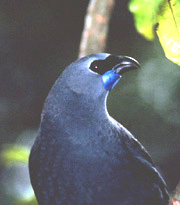
New Zealand's favourite singers .....
"The North Island kokako is a beautiful blue-grey forest bird with blue wattles and
a black 'Lone Ranger' mask, but is most famous for its haunting song. The song is long
and very loud - it is flung by the birds from the tops of emergent trees at dawn; it fills
the sky, and then settles like a huge blanket down through their forest territories".
North Island Kokako Recovery Plan, Department of Conservation
 Hear the song of kokako
Hear the song of kokako
Requires RealPlayer to run
 INSTALL REAL PLAYER INSTALL REAL PLAYER |
|
|
|
A number of small populations are maintained by intensive ecosystem management, captive
breeding and translocation. Observers noted that kokako were retreating as early
as 1885. Since 1960 when they have been confined to the central and northern North
Island, all populations in unmanaged locations have either disappeared or severely declined.
The total North Island population was estimated in 1999 to be 1160, however only 396
were females. They have existed in very small populations ranging from 17 to 500
birds in 17 isolated areas. |
|
Increase in Kokako pairs to 2003 |
|
Mapara, Te Kuiti |
5 (1989) |
40 |
|
Waipara, Pureora Forest |
16 (1998) |
77 |
|
Mangatutu, North Pureora |
8 (1995) |
33 |
|
Te Urewera National Park |
8 (1990s) |
100 |
|
Total pairs |
400 (1999) |
640 |
|
Total population |
1160 (1999) |
1700 |
|
|
In just four years from 1999 to 2003, kokako showed a most remarkable comeback with a
total population increase of 50%, and rehabitation of areas that were previously vacant. |
|
|
|
A self-sustaining population has been built up by the Department of Conservation
on Little Barrier Island in the Hauraki Gulf, which with other locations has
been a source for translocations to Kapiti Island. Kokako have also been
reintroduced to Tiritiri Matangi Island.
Kokako are very mobile on the ground and in trees, using their strong legs
to bound from branch to branch. But they have small rounded wings and are
poor fliers, tending to glide from ridges to valleys. |
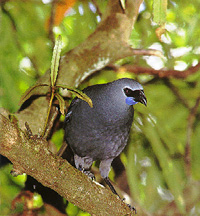 |
They defend and obtain all of their food from territories ranging in area from 4 to 20
hectares. A kokako diet includes fruits, leaves, fern fronds and various insects.
The kokako is the only bird in the world that is known to pair with another male.
The gay males build nests together. Territories can be held by a male and female
pair, two males, a single male, or briefly by one female. This is probably due to the
high mortality and lesser number of females. |
|
Next page - saddleback huia
huia
Return to wattlebirds
|
|

International Threatened
and Endangered Listings
2000 IUCN Red List of
Threatened Species
Huia
Heteralocha acutirostris
Extinct
North Island Kokako
Callaeas cinerea
Endangered
Saddleback
Philesturnus carunculatus
Lower risk near threatened
United States Threatened
and Endangered Species,
Foreign Listed Species
North Island Kokako
Callaeas cinerea
Endangered
Kokako recovery at mainland island sites .....
The main cause of kokako decline is predation at nests by ships rats, possums and sometimes
stoats and cats. The native harrier is a natural predator. The female does all
of the incubation and brooding during a 50 day period, and is most vulnerable, together with
the chicks and eggs, while on the nest. Intensive pest management has been effective
in improving breeding conditions. |
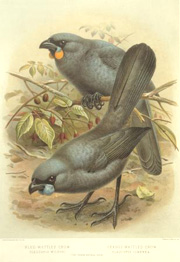
At the intensely managed Mapara Reserve in the King Country, kokako population doubled
in four years from 1992 to 1996, and then trebled after eight years of pest control. Seventeen
chicks were fledged in 1996, and 55 in 1995. The number of females increased five times
in six years. The original 1989 Mapara population of 5 reached 40 in 2003.
At Kaharoa in the Bay of Plenty, 85 percent of pairs produced chicks after three years of pest
control, but this dropped to none after management ceased.
|
|
|











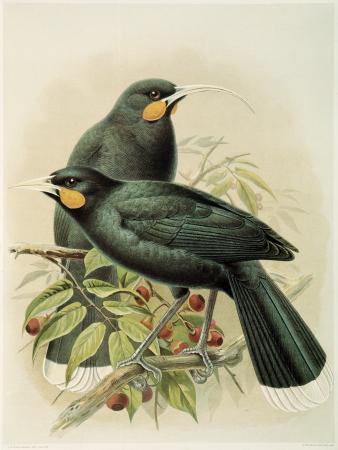

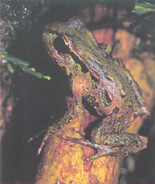
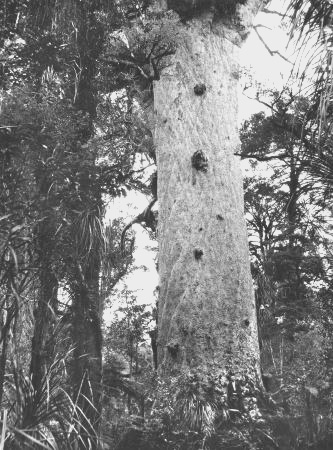





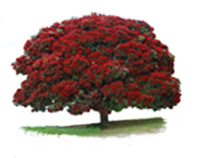
 Hear the song of kokako
Hear the song of kokako

